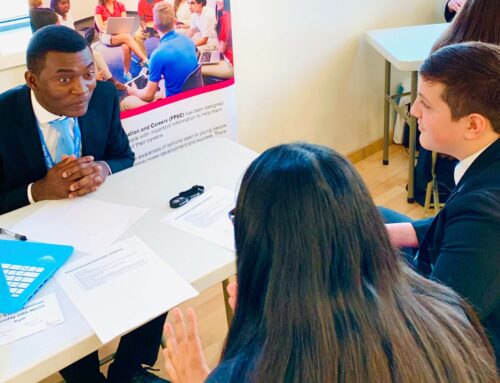
Today’s tech-savvy students have grown up with internet enabled devices in their hands. That means that in addition to the support they’ll get from teachers, parents and school careers leaders – websites and apps will increasingly be at the heart of how they choose the next steps in their education as they progress towards the exciting world of work. In this article, LinkedIn expert Philip Calvert shares an extract from his new book Kick-Start Your Career With LinkedIn.

I remember my Careers Day vividly. I walked into the school canteen in 1976 to be met by male only representatives from the Army, Navy, Airforce and several members of the Clergy. I think there might have been an accountant nearing retirement on standby too. At the time, I was really getting into photography – in particular live entertainment and rock concerts, so had been hoping that there would have been a photojournalist on hand to point me in the right direction. But I was to be disappointed. It turned out that my school only really had plans for its students to go into the armed forces or one of the professions. The university representatives were also pretty light on the ground, with Oxford and Cambridge representing the entire higher education system.
I contrast that day with the Careers event I took part in June 2019 for a local secondary school. Yes, the Armed Forces and the professions were represented, but so too were computer game manufacturers, artificial intelligence experts, satellite imaging companies, firefighters, engineers from Formula 1 and many others. It couldn’t have been more different from my own Careers Day over forty years earlier. I was there to speak to students about the use of LinkedIn and social media in the world of work. Many of them were expecting the usual ‘safety talk’ but were surprised to discover that I was advocating a different approach to how they used social media – one that would help them in university and careers choices.
Unknown to most people, LinkedIn now allows students in many countries to join the networking platform from the age of thirteen. This is a smart move on LinkedIn’s part because they figure that most teenagers will have grown up with a mobile device in their hands, and will inevitably use it to research universities, colleges, business people, entrepreneurs, companies and careers that might be of interest – all of which you can do on the site. LinkedIn is also eager for students to learn the art of social networking, so that they can begin to build their professional story online.
LinkedIn first appeared in 2003, though wasn’t the first professional networking site where you could find, connect and engage with people online. In many ways, we have lost ‘social networking’ to the noise that is now ‘social media’, but it’s vital that teenagers learn about its importance so they can start to build their online professional identity.
Transitioning from informal social media to professional social networking is a wake-up call for many. Most of the students I’ve spoken to have no idea that a future recruiter or employer might well be interested in seeing their wider social media posts – indeed, even some graduates at the University of Cambridge were shocked when I told them this. But there are some simple and practical steps that a teenager can take to start building their online identity and reputation.
LinkedIn is free to join, and whilst there is a premium version, most students won’t need it because the free version includes more than enough features to help them.
So, the first step is to create a profile with a friendly and professional photo. “Can I use a selfie?” is one of the inevitable first questions that I’m asked, and whilst the answer is theoretically correct, students soon get the idea of what is appropriate or not when I show them a selection of different photos they can choose from.
In the early days of joining LinkedIn, there’s clearly not a huge amount that you can add to your profile, but there are some important things to get you going. For example, those students who do the Duke of Edinburgh Award, can include this – regardless of what level you have reached. At the Bronze level, you are required to complete a minimum of three months volunteering, which not only gives you valuable experience, but which is also attractive to potential employers. According to LinkedIn, recruiters often consider unpaid volunteer work just as important as paid work when assessing candidates, so even if you haven’t done DofE, any volunteer work is a valuable part of your LinkedIn profile.
In my LinkedIn workshops for teenagers I go on to ask them what else they could include on their LinkedIn profile, and it doesn’t take long for them to suggest things like:
- Being able to speak another language
- Playing team sports at school
- Enjoying a regular pastime outside school
- Playing a musical instrument
- Becoming a team captain, Head Boy or Head Girl
- Getting involved in the local community
All of these are great for students to add to their LinkedIn presence, and many take to filling out their profile like a duck to water.
Older students such as sixth formers go on to add GCSE and A Level results along with any prizes and awards that they have won at school.
Other features hidden away on LinkedIn are university pages, where students can follow updates from these organisations – giving them great insights into what happens there. Students can also reach out to other LinkedIn members who have attended those universities to get the ‘insiders’ view. I also teach them the right and wrong ways to reach out and engage with people.
Yes, LinkedIn is used by many as a Jobs Site, but what most people don’t realise is that LinkedIn has changed significantly over the years. Part of LinkedIn’s strategy is to position itself as an indispensable business tool that has value for everyone – regardless of where you are in your career.
What’s really exciting is that LinkedIn is now available to students, and with care and training can be a powerful and valuable addition to how Careers professionals in schools can support their students to research higher education and careers, whilst also starting the process of building and shaping their online professional identity.
Philip Calvert is a professional speaker specialising in helping businesses to leverage LinkedIn.





